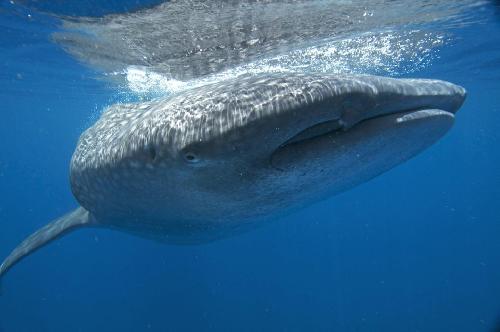Tracking whale sharks in the Gulf of Mexico revealed their use of near-surface waters, as expected, but also their use of deeper water off the continental shelf, including remaining at depth greater than 50 meters continuously for more than three days, according to a study published November 18, 2015 in the open-access journal PLOS ONE by John Tyminski from Mote Marine Laboratory, Florida, and colleagues from the US and Mexico.
Whale sharks are a wide-ranging, filter-feeding species typically observed at or near the surface, but little is known about their sub-surface habits. To examine whale sharks' long-term movement patterns, including near and offshore movements, the authors of this study attached pop-up satellite archival transmitting tags to 35 whale sharks in the southeastern Gulf of Mexico off the Yucatan Peninsula from 2003-2012 and three tags to whale sharks in the northeastern Gulf off Florida in 2010. They received data from 31 tags and 9 tags that were physically recovered provided high resolution data on vertical movement.
They found that whale sharks feeding inshore on fish eggs off the northeast Yucatan Peninsula spent extended periods surface swimming beginning at sunrise followed by an abrupt change in the mid-afternoon to regular vertical oscillations, a pattern that continued overnight. In oceanic waters, sharks spent about 95% of their time within epipelagic depths (500 m) usually during daytime or twilight hours (max. depth recorded 1,928 m). Nearly half of these "extreme" dives had descent profiles with brief "stutter steps" around 475 m deep. The authors posit that these stutter steps represent foraging events. They also found that whale sharks can remain continuously at depth (>50 m) for more than three days, suggesting they are not obligate surface feeders. Overall, the results demonstrate complex and dynamic patterns of whale shark habitat utilization, likely in response to shifting ocean conditions influencing the distribution and abundance of their prey.
 This is a whale shark. Credit: Marj Awai, Georgia Aquarium
This is a whale shark. Credit: Marj Awai, Georgia Aquarium
Dr Tyminski notes: "As the world's largest fish, the filter-feeding whale shark does not blindly vacuum the sea for food. On the contrary, these sharks show dynamic vertical movements patterns that likely evolved as an efficient means of getting the most out of planktonic prey patches both near surface and at great depths."
source: PLOS